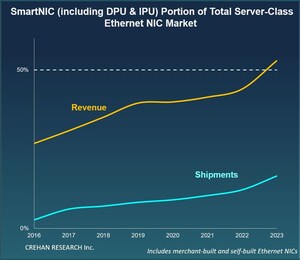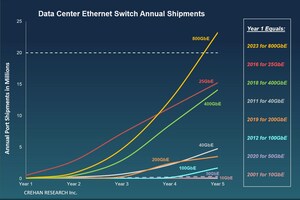10 Gigabit Ethernet (10GbE) Enters Next Major Stage of Volume Server Adoption
Public Cloud, Web 2.0 and Massively Scalable Data Centers Moving to 10GbE for Majority of Server Access
SAN FRANCISCO, Feb. 19, 2013 /PRNewswire/ -- In its recently-released 4Q12 Server-class Adapter & LAN-on-Motherboard (LOM) Report, Crehan Research sees 10 Gigabit Ethernet (10GbE) entering the next major stage of volume adoption, driven by many public cloud, Web 2.0, and massively scalable data center companies deploying 10GbE servers and server-access data center switches.
(Info: http://photos.prnewswire.com/prnh/20130219/SF62096-INFO)
"Although there is some overlap in terms of timelines and segments, we believe that we are now in the second of three major adoption stages that 10GbE server networking will follow," said Seamus Crehan, president of Crehan Research. "Each stage has distinct characteristics, resulting in correspondingly different and significant market changes and vendor impact. In the current stage, vendors stronger in the cloud segment are likely to gain market share."
As illustrated by the accompanying graphic, Crehan sees the three major stages of 10GbE mainstream server networking adoption as follows:
- First Stage: The majority of the transition during this stage happens in the 2009-2013 timeframe and mostly involves blade servers. It is driven by factors such as:
- The space, cable and component savings that 10GbE can deliver in comparison with multiple 1GbE and Fibre Channel connections, which is very important for space-constrained blade server enclosures.
- A cost-effective chip-down LOM solution using Backplane Ethernet, hence the popularity of 10GBASE-KX4 and subsequently 10GBASE-KR PHYs during this stage.
- Strong convergence and Fibre Channel-over-Ethernet (FCoE) value propositions, with 10GbE as the central technology.
- During this stage there is also some adoption of 10GbE for server access within the high performance networking and low-latency segments (for example, high frequency trading), some large cloud providers, and some enterprises. However, each of these 10GbE segments is smaller than the 10GbE blade server segment during this timeframe
- Second Stage: This stage, which we consider to be the current one, mostly involves public cloud and massively scalable data-center companies. Although there have already been some early adopters of 10GbE server and server-access switches within this segment, the confluence of high-bandwidth applications, technology maturity and attractive pricing are now leading to increased deployments. While the propensity and ability of a number of cloud providers to build some of their own custom solutions dilutes the potential market impact, data centers in this segment can be so large that even a single customer deployment can have a noticeable market impact. So far, the main 10GbE port interface type here is SFP+.
- Third Stage: This stage is characterized by the upgrading of the traditional enterprise segment's large installed base of rack and tower server ports from 1GbE to 10GbE. Crehan expects this stage to gain good traction in 2013. Since much of the infrastructure in this segment is 1GBASE-T, Crehan forecasts that this is where 10GBASE-T will start to see mainstream adoption, and it predicts strong growth for this technology. Crehan also anticipates that this stage will offer the largest server-access port and revenue opportunity.
Crehan expects that server networking bandwidth will see a five-fold increase over the next five years as we move through these upgrade stages.
About Crehan Research Inc.
Crehan Research Inc. produces reports with very detailed statistics and information on the Data Center Switch and Server-class Adapter & LOM/Controller markets. The company's reports are supported with rich insights and context to deliver increased value. For more information about Crehan Research Inc. email [email protected], phone 650-273-8400, or visit www.CrehanResearch.com.
SOURCE Crehan Research Inc.
WANT YOUR COMPANY'S NEWS FEATURED ON PRNEWSWIRE.COM?
Newsrooms &
Influencers
Digital Media
Outlets
Journalists
Opted In





Share this article